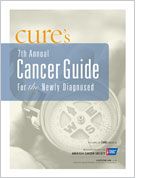Publication
Article
CURE
At Diagnosis: Identifying Genetic Risks
Steps patients can take if cancer runs in the family
Many cancer begin as a fluke mutation in a single cell. Yet in about 10 percent of cancer cases, one or more mutations wind their way through some family trees with about a 50-50 chance of striking each new member. When mutations are deemed hereditary, they are present in every cell, including egg and sperm, and can thus be passed to offspring.
Each person has 46 chromosomes—23 from each parent—which contain 25,000 to 30,000 genes. These chromosome pairs allow for a backup, so a mutated gene’s healthy counterpart can code for the correct protein. For cancer to develop, both copies of the gene must be affected.
Inherited mutations will only make a person susceptible to cancer. But because the mutation is in every cell, the healthy gene will need to mutate in only one cell to jump-start cancer or lose the ability to suppress cancerous mutations from occurring in other genes. Due to random errors in DNA division and augmented by carcinogens, oxidative stress and even radiation from sunlight, the probability of a second mutation is high.
Genetic testing, requiring little more than a simple blood draw, is now available for dozens of hereditary cancer syndromes, most of which are caused by alterations in genes that suppress tumor growth.
To date, the most commonly requested test is for BRCA1 and BRCA2. Alterations in these two genes predispose individuals to breast, ovarian and other cancers. Although these mutations can affect people of any race or ethnicity, they are found more frequently in Jewish families of Ashkenazi (Eastern European) descent. Among female carriers, BRCA alterations may confer a lifetime breast cancer risk of up to 85 percent (though new research suggests breast cancer risk varies among families and may only be as high as about 50 percent) and an ovarian cancer risk of up to 30 percent. Male carriers also have increased risk for breast, prostate and other cancers.
Other frequently used genetic tests are for two colon cancer syndromes: hereditary nonpolyposis colon cancer (HNPCC) and familial adenomatous polyposis (FAP). Both syndromes are associated with a high risk for colon cancer (80 percent and virtually 100 percent, respectively), as well as other cancers.
Recently, several familial syndromes have been linked to kidney cancer. In von Hippel-Lindau disease, patients inherit a defect in a specific gene called von Hippel-Lindau (VHL), though people without the inherited disease can also have problems with the VHL gene. The VHL gene is a tumor suppressor gene, so its inactivation can cause up to 80 percent of all sporadic (non-hereditary) clear cell renal cell carcinomas, the most common type of kidney cancer. These discoveries have given researchers a specific target for developing therapies to treat kidney cancer.
For those who test positive for certain genetic mutations, increased screening is needed. Some patients may also consider chemoprevention strategies to help lower their risk of second cancers or recurrence. In other cases, cancer may be prevented using prophylactic (preventive) surgeries, behaviors and medicines.
Because gene alterations often predispose individuals to many types of cancer, identifying genetic status early can aid in diagnosis and medical decisions.






